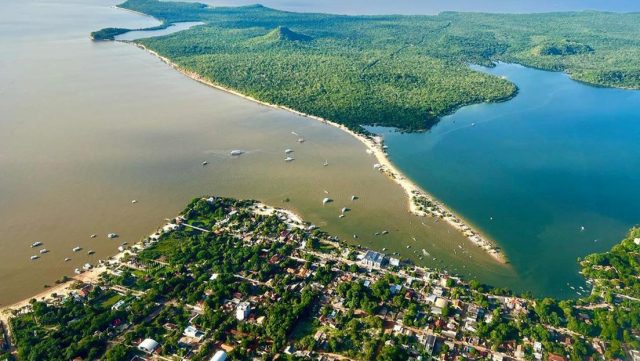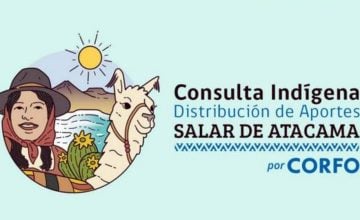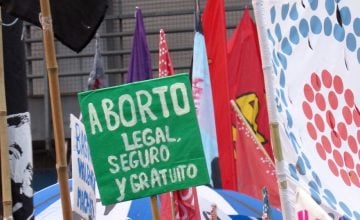Known as «the Brazilian Caribbean», Alter do Chao is one of the main tourist postcards of the Amazonian state of Pará. A paradise of white sand and crystal clear waters that have a disturbing muddy color as a result of illegal mining.
Environmentalists and residents of Alter do Chao, located in the municipality of Santarém, on the banks of the Tapajós River, affirm that this phenomenon is largely due to the ‘garimpo’, the illegal mining practiced some 300 kilometers from this place, in Middle and Upper Tapajós regions.
The increase in the turbidity of the river’s waters is not a new phenomenon, but until now it had not reached Alter do Chao. Every year, in the rainy season, between December and January, natural sediments from the Amazon River are dragged and enter the Tapajós through channels that connect both, which darken the waters that later recover their color.
However, the increase in its intensity and its prolonged duration throughout this year is what has caught the attention of researchers, explains journalist Marta Miera for RT.
The non-governmental organization Mapbiomas traced the path of the sediments using satellite images, and concluded that part of the increase in the turbidity of the waters is due to waste from illegal mining.
Mapbiomas warns that illegal mining in the Amazon has multiplied in recent years and one of the regions where there has been a more significant increase is in the Tapajós basin.
The extraction area tripled in the last 10 years: it went from 21,437 hectares in 2010 to 68,351 hectares in 2020.
Most of that activity is concentrated on protected indigenous lands. In the Munduruku indigenous territory, in Alto Tapajós, the area devastated by the ‘garimpo’ increased by more than 363% in two years.
“Due to the pandemic, in recent years the value of gold has risen a lot, while inspection has decreased. We have a government that in a certain way is in cahoots with the ‘garimpeira’ activity”, says Caetano Scannavino, coordinator of the Saude e Alegria project, to RT.
To search for gold, the miners excavate the Amazonian soil or dredge the bottom of the rivers. The sediments are discarded directly from the extraction plants to the rivers and this extra contribution modifies the physicochemical characteristics of the water and its color. These get together with the natural sediments that the rain drags down.
The advance of mining causes health problems
As a precautionary measure, some ‘ribereños’ ( populations that live on the banks of rivers) have stopped using the water for fear of contamination.
“We know that a good part of the diseases have water links. We have already seen the Munduruku population with mercury levels above that tolerated by the World Health Organization”, denounced Scannavino.
Mercury used in illegal mining contaminates rivers and the fish that local populations feed on, posing a serious health risk.
But there are other very dangerous phenomena. The doctor in biological sciences, Dávia Talgatti, who is part of the team from the Federal University of the West of Pará, has been analyzing the waters of the Tapajós since 2020.
Talgatti explains to RT that other reasons why the waters have darkened are the algae, cyanobacteria, that proliferate in the river due to the contamination of the tributaries and that these produce cyanotoxins, extremely harmful to health.
«This is very serious because they can cause various problems in humans such as liver complications, including liver cancer, gastrointestinal, neurological and skin problems», she warns.
The researcher highlights the pressure on the river caused by humans. «We ‘fertilize’ with chemical nutrients through plantations on the banks of the river, with mining or through untreated wastewater. Organisms take advantage and multiply very quickly», she points out.
A blow to tourism
In addition to the concerns about the environmental impact on one of the most important rivers in the country, the inhabitants are also concerned about the blow that it represents for tourism in Alter do Chao. Some tourist companies even warn of the situation on their social networks.
“The river that was once mesmerizing blue is now like this! Muddy waters, full of waste harmful to health. Tapajós is dying!”, writes a tour company, asking for help.
«The area has gigantic potential and the possibility of bringing income, economy, generating resources and valuing culture by mobilizing communities», says Scannavino, who asks to avoid sensationalism, because tourist activity continues.
What is necessary – he adds – is for the State to carry out strong action to combat environmental crimes.
“A policy of alternative incentives to ‘garimpo’ should be developed, because it is an activity that has been going on for more than 70 years and there is already an economic culture based on it”, he concludes.
At the moment, the Police are already investigating the reasons for this change in color in the river, and experts from the country’s main environmental institutes have traveled to the site to analyze the case. The authorities consider that it is still early to draw conclusions.











